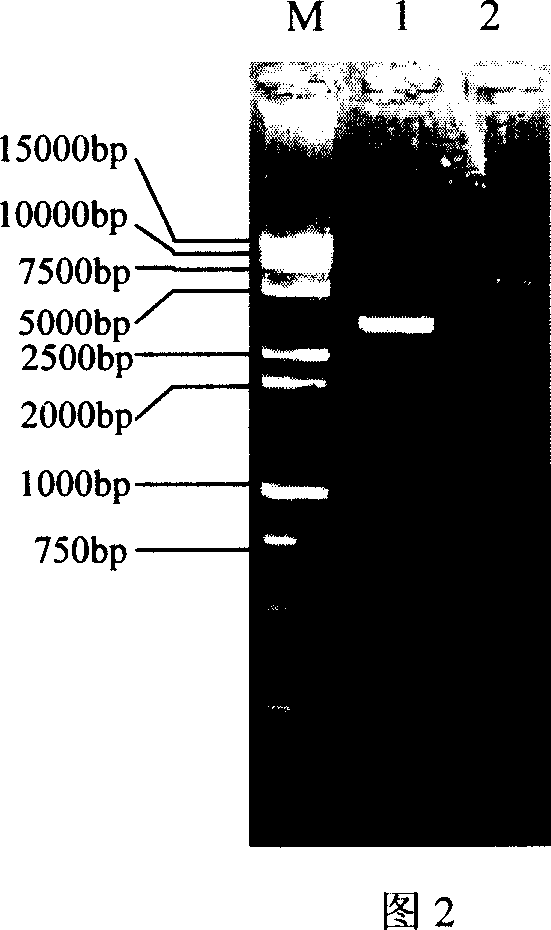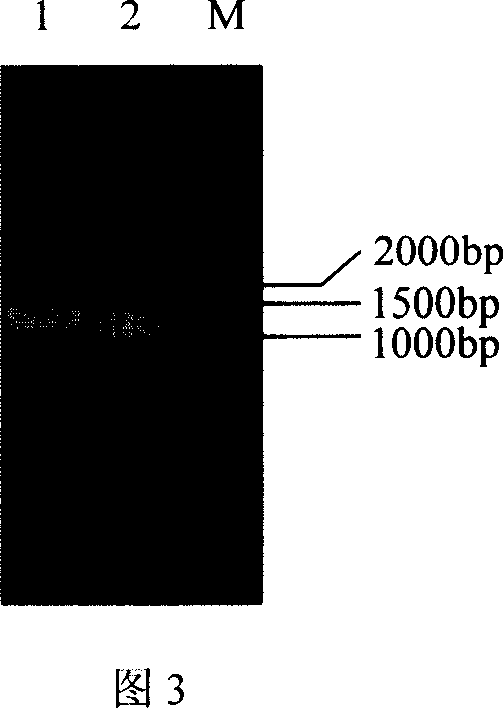Chicken infectivity bursa of Fabricius virus VP2 cDNA, its expression vector, expressed recombinant protein and application thereof
A technology of bursal disease and chicken infectivity, applied in the field of cDNA, achieves the effect of low price, preventing loss, and simple cultivation
- Summary
- Abstract
- Description
- Claims
- Application Information
AI Technical Summary
Problems solved by technology
Method used
Image
Examples
Embodiment 1
[0050] [Example 1] Synthesis and cloning of recombinant chicken infectious bursal disease virus VP2 cDNA
[0051] 1. Extraction of viral RNA The bursa of SPF chickens infected with chicken infectious bursal disease virus supervirulent Gx (vvIBDV-Gx) strain was ground with a grinder. Take 200 μl of disease material and add TE (PH8.0) to 500 μl, add 5 μl of proteinase K and 50 μl of 10% SDS, and bathe in water at 56°C for 3 hours. Add an equal volume of phenol / chloroform for extraction three times, and an equal volume of chloroform for extraction once. Remove the supernatant to another 1.5ml centrifuge tube, add 1 / 10 volume of NaAc (3M, pH 5.2), and equal volume of isopropanol, and precipitate at -20°C for 2 hours. Centrifuge at 12000 rpm for 15 minutes at 4°C and wash once with 75% ethanol. Dry in vacuo and redissolve RNA in RNase-free deionized water.
[0052] 2. Obtaining the RF243 gene of the genome fragment A. Perform RT-PCR on the extracted viral RNA, and use random pri...
Embodiment 2
[0059] [Example 2] Construction and identification of recombinant yeast vector
[0060] 1. Construction of recombinant yeast vector The optimized VP2 gene and yeast vector were digested with Xhol I and Xba I respectively, and recovered with an agarose gel recovery kit. The vector is dephosphorylated with CIAP. T for foreign fragments and vectors 4 DNA ligase performs the ligation reaction. See Figure 1 for the construction map. The ligation product was transformed into E. coli competent cells.
[0061] 2. Extraction and Identification of Recombinant Plasmids Add corresponding antibiotics to low-salt LB according to the concentration of action (screen pPICZαVP2 plasmid antibiotics and select Zeocin TM ), pick a single colony and inoculate LB. Plasmids were extracted by alkaline lysis. Identify by PCR method, PCR identification primer and condition are the same as embodiment 1, PCR amplifies 1.3Kb band (Fig. According to the results of gene sequencing, the gene insertion ...
Embodiment 3
[0062] [Example 3] Transformation of recombinant yeast vector, detection and screening of recombinant yeast strains
[0063] 1. Transforming yeast competent cells Linearize the recombinant yeast vector with Sac I, transform yeast competent cells, and follow the guidance method of Pichia pastoris electroporation from Invitrogen Company. Yeast after transformation is coated with YPDS plate containing antibiotic (select the recombinant yeast antibiotic that pPICZαVP2 transforms to select Zeocin TM ).
[0064] 2. Screening and identification of yeast recombinants Pick 10 single yeast colonies, inoculate 5ml of YPD containing antibiotics, culture overnight, centrifuge, discard the culture medium, and wash once with 5ml of sterilized deionized water. Apply proteinase K and SDS to digest the yeast overnight, centrifuge, transfer the supernatant to another 1.5ml centrifuge tube, extract 3 times with phenol and chloroform, and precipitate with absolute ethanol. AOX1 5` and 3` primers...
PUM
 Login to View More
Login to View More Abstract
Description
Claims
Application Information
 Login to View More
Login to View More - R&D
- Intellectual Property
- Life Sciences
- Materials
- Tech Scout
- Unparalleled Data Quality
- Higher Quality Content
- 60% Fewer Hallucinations
Browse by: Latest US Patents, China's latest patents, Technical Efficacy Thesaurus, Application Domain, Technology Topic, Popular Technical Reports.
© 2025 PatSnap. All rights reserved.Legal|Privacy policy|Modern Slavery Act Transparency Statement|Sitemap|About US| Contact US: help@patsnap.com



